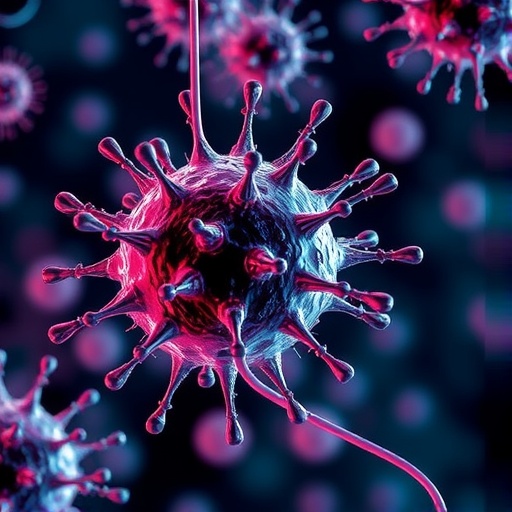The recent breakthrough in our understanding of how immune cells act reveals crucial insights into the intricate relationship between lipid metabolism and immune responses, particularly in how natural killer (NK) and T cells release their lethal cargo. This newly published research, spearheaded by a collaborative team of scientists from some of Europe’s leading biomedical research institutions, underscores the complexity of cellular interactions that govern immune defenses. The findings discussed in the journal Science Immunology pave the way for novel therapeutic approaches in combating diseases caused by genetic anomalies.
Natural killer cells and T cells are the frontline defenders against viral infections and cancerous transformations within the human body. They meticulously patrol our tissues for signs of danger, ready to deploy cytotoxic granules, which are minuscule packets loaded with toxic molecules designed to eliminate affected cells. Historically, the mechanisms underlying the release of these granules have remained somewhat nebulous, with scientists focusing primarily on the role of well-documented proteins and pathways. However, this recent investigation highlights that lipid metabolism plays a surprisingly pivotal role in facilitating these immune processes, an understanding that could revolutionize both immunology and therapeutic strategies.
The research team, led by Professor Kaan Boztug and comprising experts such as Assistant Professor Artem Kalinichenko and former PhD student Jakob Huemer, utilized a cutting-edge CRISPR-based genetic screening approach. This technological innovation allowed them to dissect and identify an unanticipated array of genes integral to the precise regulation of cytotoxic granule release. To their astonishment, many of these discovered genes are significantly correlated with cellular lipid metabolic processes. This observation suggests a sophisticated interplay in which lipids not only supply energy but also aid in the spatial organization of critical proteins and organelles necessary for immune functions.
Lipids have often been relegated to secondary roles in cellular biology, primarily viewed as structural components or energy reserves. However, their newfound importance in immune response challenges long-held perceptions. The research elucidates that specific lipids guide essential proteins to strategic locations within NK and T cells, ensuring the granules can be accurately positioned for release. This precise spatial regulation is paramount, as errors may lead to inefficient immune responses or pathological consequences.
The implications of these findings extend beyond mere cellular mechanisms; they touch upon understanding various diseases characterized by immune dysfunction. The study’s authors note that the connection between lipid metabolism and immune cell function may hold keys to deciphering certain rare genetic disorders and inherited immune deficiencies. By unveiling these novel genetic pathways, researchers can forge ahead in developing diagnostic tools that better identify and manage conditions that impair the immune system, significantly enhancing patient care.
Moreover, the study posits that proteins originally recognized in neurological contexts, often associated with lipid metabolism, are also critical to immune system functionalities. This cross-disciplinary insight not only broadens the scope of immunology but also encourages exploration into potential overlaps between seemingly distinct biological systems. The phenomenon of shared pathways across diverse cellular functions could lead to innovative strategies for treating diseases that were previously thought to be unrelated.
The excitement amongst the research teams is palpable as they recognize the far-reaching consequences of their work. As co-first author Artem Kalinichenko aptly points out, understanding the role of these newly identified genes can reshape our comprehension of T cell and NK cell functionality. This revelation can catalyze additional research into therapeutic interventions, particularly in areas such as immunotherapy for cancer, where harnessing the body’s immune response can lead to remarkable outcomes in patient survival rates.
Furthermore, the study emphasizes the importance of collaborative, curiosity-driven research, which illustrates how various scientific disciplines can converge to unravel complex biological phenomena. The interconnectedness of lipid biology with immune responses exemplifies the type of integrative approach necessary for cutting-edge discoveries in modern medicine. As healthcare continues to evolve, fostering such collaborations across institutional lines will be essential to address pressing medical challenges.
In conclusion, this groundbreaking research not only heralds a deeper understanding of how our immune system operates but also lays the foundations for future inquiries into the therapeutic potential of targeting lipid metabolism pathways. As scientists continue to unlock the secrets of cellular behavior, the insights garnered from this study could inspire a new wave of approaches in immunology and disease treatment, potentially transforming how we understand and combat health challenges ranging from cancers to genetic disorders.
Collectively, the research underscores the need for a paradigm shift in how we approach the intersection of metabolism and immunity in our quest for more effective medical interventions. With the ever-evolving landscape of immunology, this study serves as a critical reminder that the answers we seek may often lie in unexpected connections, beckoning researchers to explore the complexities of life at a molecular level.
Subject of Research: Cells
Article Title: Protein palmitoylation and sphingolipid metabolism control regulated exocytosis in cytotoxic lymphocytes
News Publication Date: 17-Oct-2025
Web References: Science Immunology
References: N/A
Image Credits: ©St. Anna CCRI
Keywords
Immune cells, Immune response, Natural killer cells, Lipid metabolism, Genetic disorders, Genome editing
Tags: cellular interactions in immune defensecollaborative biomedical research in Europecytotoxic granules releaseimmune cell transport mechanismsimmunology breakthroughs 2023lipid metabolism in immune responsesnatural killer cells functionnovel treatments for immune-related diseasesScience Immunology journal findingsT cells and cancer defensetherapeutic approaches for genetic diseasesviral infections and immune response





